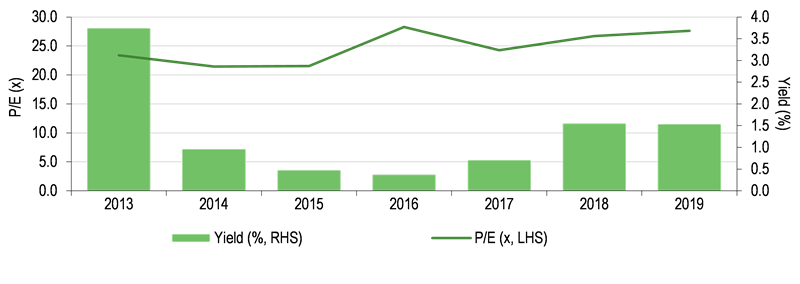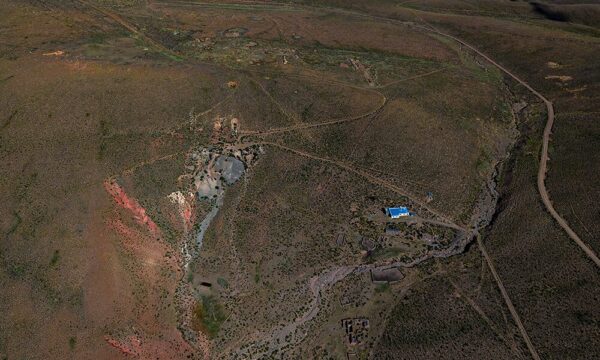Newmont was founded by William Boyce Thompson in 1916 as a holding company for his mineral and mining interests. According to company folklore, the name Newmont is a conflation of Montana (where Colonel Thompson was born and raised) and New York (where he made his fortune).
After joining his father in a number of mining and lumber ventures in the 1890s, Colonel Thompson moved east to New York to become a mine promoter and stockbroker at Hayden, Stone & Co, where he amassed a fortune developing low-grade, large-scale porphyry copper deposits. His successes included the Shannon Copper Company (now part of the Morenci open pit in Arizona, the largest in the US), Nevada Consolidated (which eventually became a part of Kennecott), Mason Valley (where a smelter town was named after him), the Magma mine at Superior, Arizona, which became a major copper producer, and the promotion of the high-grade Inspiration Copper Company also in Arizona. In addition to copper, he also financed lead, zinc and coal mines, steelworks and promoted the Nipissing Silver deposit in Ontario and his interests were distributed from as far north as Canada to as far south as Peru. His portfolio of non-mining interests included refinancing the American Woollen Company, launching the Cuba Cane Sugar Company, gaining control of Pierce-Arrow Motors, organising the Wright-Martin Aero Company and serving on the boards of the Metropolitan Insurance Company, Sinclair Oil and Gulf Sulphur, among others. He retired from the New York stock exchange in 1915 and created Newmont Mining Corporation in 1916 to house his mining interests.
Thompson made a number of trips to Russia around the time of the revolution ostensibly to encourage the formation of a democratic government. For his work there, he was a awarded the honorary title of colonel by the American Red Cross.
In the US, he was prominent behind the scenes in the Republican party, a presidential elector and party chair. He served on the board of the Federal Reserve Bank of New York from 1914 to 1919 and was twice a delegate to the Republican National Convention in 1916 and 1920. In 1921, he declined nomination for a cabinet post under President Warren Harding.
He became ill in 1925, while scouting for mining properties in South Africa, and died of pneumonia in 1930. He is buried at Sleepy Hollow cemetery on the outskirts of New York City.
By the time of his death, Newmont Mining had developed into one of the world’s largest financiers of copper mining projects.
Organisation and reorganisation
One of Newmont’s earliest investments included grassroots funding of Sir Ernest Oppenheimer’s Anglo American Corporation of South Africa in 1917 (the forerunner of today’s Anglo American (AAL) and, then, more of a diamond company than a gold one), giving Newmont a 25% interest in the newly created company. Note that, had Newmont followed its interest in AAL, then 25% of AAL’s current market capitalisation would today have a value of c US$11.0bn.
In 1925, Newmont diversified via the acquisition of oil interests in Texas. Eventually, Newmont's oil interests would encompass more than 70 blocks in the Gulf of Mexico as well as production assets in the North Sea.
In 1929 (shortly before the death of Colonel Thompson), Newmont became an operating company in its own right with the acquisition of California's Empire Star Mine. By 1939, it was operating a further 11 gold mines, all in North America. However, it also maintained its interest in southern Africa and, in the decades around the middle of the 20th century, it had controlling interests in both the Tsumeb copper mine in Namibia and the O’Okiep Copper Company in South Africa.
The company’s transition into the modern era began with its discovery of the world’s first invisible gold at Carlin in Nevada in the early 1960s. The Carlin Trend (or Unconformity) as it is now called is a belt of gold deposits, approximately 5 miles (8km) wide and 40 miles (60km) long, located in the north-east of Nevada extending in a north-north-westerly direction. It was created approximately 350 million years ago by a collision between the North American Plate and a terrane that induced higher crustal temperatures and pressures and numerous hot springs along the suture zone. Several episodes of subsequent subsurface magmatism are known to have occurred and, during each of these, hot springs brought dissolved minerals (including gold and silver) toward the surface where they precipitated out, primarily in Paleozoic limy sediments. Gold was discovered in the area as early as the 1870s. Owing to its fine and disseminated nature however, the potential of the region was largely overlooked and, prior to 1964, only c 22,000oz of gold had been produced (ie an average rate of only 240oz per year). However, Newmont opened the world’s first open-pit gold mine there in the early 1960s and, in 1971, began to use heap leach technology on lower-grade ores (NB perhaps not coincidentally, South African gold production peaked in 1972) and, in the 57 years since its discovery, more than 70Moz gold have been produced (ie at an average rate in excess of 1Moz per annum), making Carlin the largest gold discovery in north America in the 20th century and one of the world’s richest mining districts.
In the 1980s, Newmont thwarted five takeover bids: from Cecil Rhodes’s Consolidated Gold Fields (Cons Gold, the forerunner of Gold Fields of South Africa), the legendary business magnate, oil tycoon and corporate raider, T. Boone Pickens, Minorco (then the off-shore arm of Anglo American), Hanson (the ultimate buyer of Cons Gold after the latter’s successful defence against Minorco) and Sir James Goldsmith. NB None of these takeover bids was independent of any of the others and readers with an interest in the history of mining, gold, mining finance, the Oppenheimer family, Consolidated Gold Fields, Anglo American/Minorco/De Beers, imperial, post-imperial and apartheid relationships and one of the most acrimonious attempted takeovers in corporate history are strongly advised to read Consolidated Gold Fields in Australia: The Rise and Decline of a British Mining House, 1926–1998, published by ANU Press.
After 1987, Newmont underwent a major restructuring. This included a divestment programme involving all of its copper, oil, gas and coal interests and the payment of a US$33/share dividend to shareholders (to put this into context, in the first half of 1987, Newmont’s share price averaged just US$34.76/share). A year later, it moved its headquarters from New York to Denver.
In 1997, Newmont merged with the Santa Fe Pacific Corporation to form North America’s largest gold producer. Starting in 2000, there then followed one and a half decades of rapid, but targeted, corporate development, including:
■
On 21 June 2000, it announced a merger with Battle Mountain Gold.
■
In February 2002, it completed the acquisition of Normandy Mining and Franco-Nevada. Newmont faced competition in its bid for Normandy from AngloGold. However, it eventually outbid the South African company to become the world's largest gold producer, with annual production in excess of 8Moz pa.
■
In 2007, Newmont eliminated its 1.5Moz legacy hedge book to make itself the world's largest unhedged gold producer.
■
In 2008, it acquired Miramar Mining Corporation and its Hope Bay deposit in the Canadian Arctic.
■
In late 2008, Newmont moved its headquarters from Denver to the suburb of Greenwood Village, Colorado.
■
In 2009, it purchased the remaining one-third interest in Boddington Gold Mine that it did not already own from AngloGold Ashanti.
■
In April 2011, it acquired Fronteer Gold for C$2.3bn.
■
In 2019, it acquired Canada's Goldcorp which, once again, had the effect of making it the largest gold producer in the world. Under the terms of the agreement, Newmont undertook to acquire all outstanding equity of Goldcorp at an exchange ratio of 0.3280 Newmont shares plus US$0.02 in cash for each Goldcorp share. At the time of the announcement, the consideration represented a 17% premium based on Newmont’s and Goldcorp’s 20-day volume weighted average price and implied an equity value for the latter of US$10bn and an enterprise value of US$12.5bn, with Newmont and Goldcorp shareholders owning c 65% and 35% of the combined entity, respectively. The transaction was approved unanimously by both boards of directors and, in the case of Goldcorp, also on the unanimous recommendation of a special committee of independent directors. To date, Newmont reports that it has exceeded the synergies that it estimated could be generated from the merger of the two companies – among other things, this has included resolving the dispute around transportation at Penasquito within one year of the merger being completed. While it was not an explicit goal of the merger at the time, one of its unintended consequences has been that the enlarged Newmont has no need of executing any further merger & acquisition activity for potentially three decades as it instead focuses on generating returns organically from its portfolio of existing assets.
In addition to buying assets, Newmont has shown itself willing to divest itself of them as and when it deems such sales appropriate. Since its acquisition of Goldcorp, this has included the sale of its stake in Continental Gold for a cash consideration of US$260m, the sale of Red Lake for cash proceeds of US$375m (plus potentially a further US$100m, contingent upon future exploration success) and its 50% stake in Kalgoorlie to Northern Star for US$800m, also in cash, thereby meeting its target of US$1.0–1.5bn in divestments within the space of a year.
Just as it was concluding its acquisition of Goldcorp, Newmont simultaneously concluded a deal with Barrick whereby the two agreed to combine their Nevada Carlin assets into a joint venture owned 38.5% by Newmont and 61.5% by Barrick, called Nevada Gold Mines. Assets contributed to the joint venture by Newmont included Carlin, Twin Creeks, Phoenix, Long Canyon and Lone Tree, while assets contributed by Barrick included Goldstrike, Cortez, Turquoise Ridge, Gold Rush and South Arturo plus an assortment of associated processing and other infrastructure.
At the moment of its creation, the new joint venture comprised 10 underground and 12 open-pit mines, two autoclave facilities, two roasting facilities, four oxide mills, a flotation plant and five heap leach facilities. Within this portfolio were three of the world’s top 10 tier one gold assets, namely Goldstrike/Carlin, Cortez and Turquoise Ridge/Twin Creeks), with potentially another one (Goldrush) to add to its ranks. In 2018, total production from these assets amounted to 4.1Moz gold (cf total production from South Africa that year of 130t, or 4.2Moz), making the Nevada complex by far the largest single gold mining entity in the world and more than twice as big as its next nearest rival.
At the time of the transaction, Barrick estimated that it could extract synergies from the combined entity of US$500m per year in the first five years of operation, worth an estimated US$4.7bn in total before tax, including:
■
optimisation of ore sources and production schedules at appropriate plants,
■
optimisation of administration and regional business centres,
■
optimisation of transport and warehousing costs and facilities,
■
optimisation of supply chain costs, and
■
optimised utilisation of resources and exploration potential via a district-wide geological approach.
These, in turn, would create a virtuous cycle, leading to:
■
lower costs and higher free cash flows,
■
increased reserves and resources, and
■
longer profitable mine lives.




















